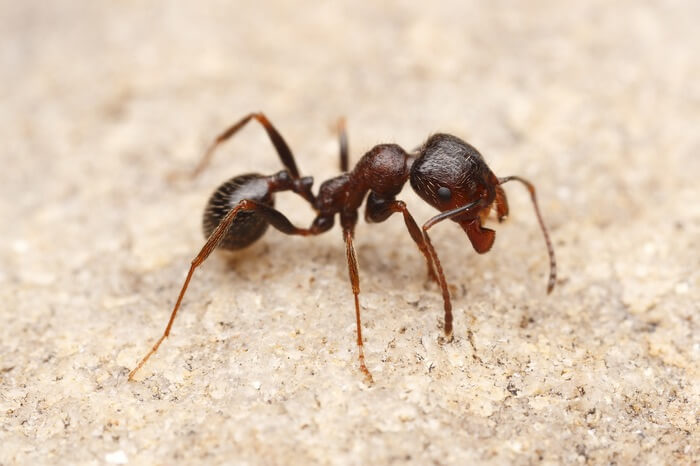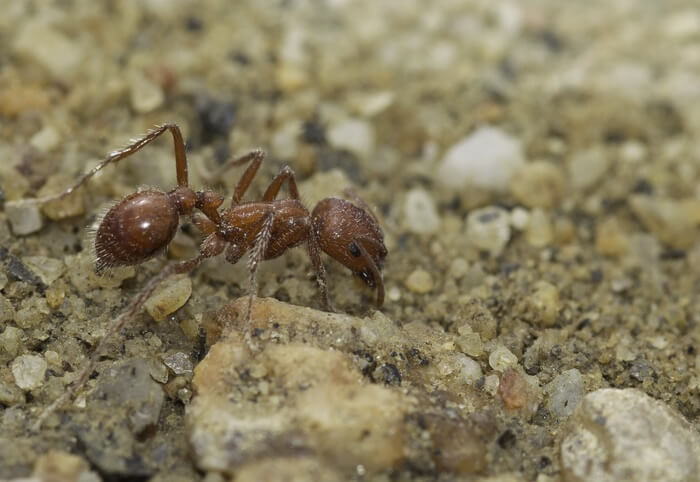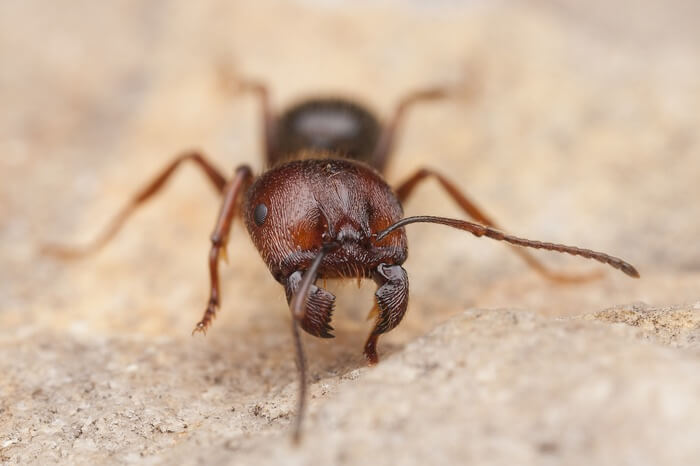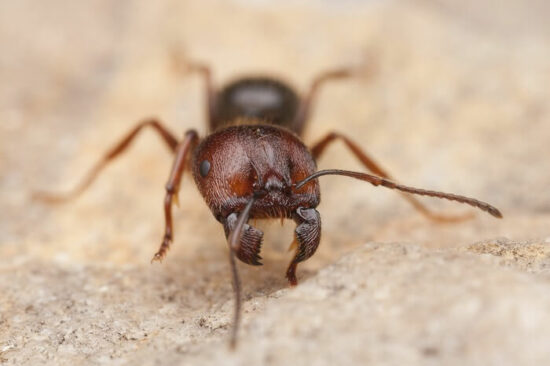Knowing how to get rid of harvester ants is important for many homeowners. While these insects aren’t as destructive as some other common species, they can be a real nuisance if not properly controlled.
This guide will teach you how to kill harvester ants quickly and efficiently.
Table of contents
What Are Harvester Ants?
Harvester ants are unique insects with distinct appetites. Unlike other ant species, harvesters don’t rely on familiar food sources like sweets and aphids.
They’re native to the Southwestern United States and often inhabit large plains with very little shade. Common ant foods are scarce in their natural environment, so they resort to collecting seeds and mushrooms. They can also eat dead insects, but their main target is starch-based foods.

As their name implies, these ants are skilled foragers. They create massive colonies with deep chambers to store food. Some of the deepest harvester ant nests were nearly 20 feet below the soil’s surface! This makes getting rid of harvester ants challenging.
In terms of appearance, harvester ants are pretty simple. They’re about a quarter of an inch to half an inch long. Several subspecies exist, but most harvester ants are reddish-brown in color.
- Kills common household ants including acrobat, crazy, ghost, little black, odorous house, pavement, and other sweet-eating ants
- As worker ants discover the bait, they share it with the rest of the colony to eliminate them all
- You should see a significant decrease in the number of ants visiting the bait stations within just a few days
- Place stations near areas where you’ve seen ant activity
These insects are often mistaken for garden-variety fire ants. But if you look closely, you’ll notice a couple of standout differences.
The most significant indicator that you’re dealing with a harvester ant is the shape of the head. Instead of the rounded dome of the fire ant, this species has a square-shaped head. Two large mandibles flank both sides and give the ant the ability to chew through tough seeds without missing a beat.
The ants also have a pair of spines separating the abdomen and the thorax. They look like two rounded nodules, making them easy to spot.
Quick Tip: Harvester ants are relatively inconspicuous compared to other species. Their nests look like a small bare patch of land surrounded by healthy vegetation. Most of the majesty of the ant’s home is underground and out of view.
Is It Important To Keep Them Under Control?
Harvester ants aren’t all bad. In fact, many farmers welcome them onto their land!
The ant’s foraging behavior can do a lot to improve farmland. The movement between layers of soil increases aeration, which only benefits plants. If organic material like compost is in the ground, the harvester ants can help mix things together and create a nutrient-rich planting medium.
On top of all that, their activity helps to disperse seeds and increase the survival rates of young seedlings.
Of course, they can do some damage. Harvester ants are particularly annoying for cattle farmers, as their foraging disrupts grass growth and leaves less food for bovines.
Whether or not you need to get rid of harvester ants is up to personal preference. Most homeowners don’t pay them any attention. That is, however, until they start growing in numbers.

If you notice a sizable population already, it’s a good idea to nip this ant issue in the bud before it gets out of hand.
You see, harvester ants are capable of living a long time. Colonies survive as long as the queen is still producing offspring. Some harvester ant subspecies have queens that can live up to 30 years!
To make matters worse, harvester ants populations proliferate very quickly. In only five years, a small colony can grow to an ant workforce of over 12,000!
Nests of that size will wreak havoc on your yard. So, it’s better to get rid of harvester ants before they get all over the place.
Quick Tip: Signs of a potential infestation include patches of bare land that are free of vegetation. If you usually have grass, you may notice it begin to die out around entry points to nests. After further development, mounds might start to form as well.
How To Get Rid Of Harvester Ants
No matter your reasoning, there are several ways to get rid of harvester ants once and for all. Because they are elusive and usually nothing more than a nuisance, there’s no need to take extreme measures like you would with many other common pests.
Killing harvester ants is pretty straightforward, but it requires patience if you want to see the best results. Here are some tried and true methods to get rid of harvester ants.
1. Bait
Bait products are your best bet if you want long-term success when getting rid of harvester ants.
- Kills common household ants including acrobat, crazy, ghost, little black, odorous house, pavement, and other sweet-eating ants
- As worker ants discover the bait, they share it with the rest of the colony to eliminate them all
- You should see a significant decrease in the number of ants visiting the bait stations within just a few days
- Place stations near areas where you’ve seen ant activity
Surface-level products aren’t going to cut it with these critters. Remember, their nests can extend several feet into the ground! Plus, the large numbers make it impossible to get all the ants at once with basic on-contact killers.
To effectively wipe out a colony, you have to use ant bait traps. This is a smarter method that uses food to attract worker harvester ants..
Quick Tip: You’ll ideally want to pick up traps that use starchy bait foods.
Eventually, worker ants will find the traps and create pheromone trails to alert others. They’ll take it back to the nest and, hopefully, spread it to others.
While the bait food looks like a standard find for these harvester ants, it’s laced with slow-acting poison. This is actually one of the most common ways that homeowners kill ants with borax. It takes up to 48 hours for the toxin to destroy the digestive and nervous systems. By that point, it’s already made the rounds and was enjoyed by other ants.
The goal is to kill the queen harvester ant. Doing so will destroy the entire colony.
Thanks to the deep and complex maze of tunnels in the nest, it could take several applications to get to her. Be vigilant and place traps around the nest. Put them near known scent trails and replace the bait regularly.
With time, you should be able to kill and get rid of the harvester ants you have on your property.
2. Powder Insecticide
While bait traps are the most effective choice for long-term results, there are some ways to get near-instant results.
Powder insecticides can kill harvester ants on contact. How they work depends on the solution itself.
Natural powder products like diatomaceous earth dehydrate the insect. It causes tiny lacerations that make the ant lose liquids and die off. Sprinkle it around the nest, and the ants have no choice but to walk in it!
Chemical-based powders are available as well. They also work on contact. However, you can apply them like a liquid and inject them directly into the nest entrance.
The powder will quickly fill the voids and get on any ants in the way. Those ants will spread it even further and, hopefully, get some down to the queen.
Once again, different formulations have different effects. Some will suffocate the ants by clogging breathing holes. Others will rely on accidental ingestion to poison the ant.
Either way, powder insecticides work very well and can provide quick results whenever you’re in a pinch.
3. Commercial Sprays
Of course, you can always use commercial spray products to kill and get rid of harvester ants. Ant-killers are available in most stores and contain a cocktail of chemicals that can exterminate harvester ants on contact.
But remember, commercial sprays don’t have a significant impact beyond the ants you can see. They’re surface-level killers that have to make direct contact with the harvester ants to eradicate them. That means the ones hiding out in the deep tunnels of the nest aren’t going to be affected. The same goes for the heavily protected queen.
However, that doesn’t mean that it’s not a powerful tool to have in your arsenal! Commercial sprays can do a lot to lower numbers and destroy the nest.
Quick Tip: Apply the spray on a hot day. Harvester ants tend to be less active when the temperatures are high. Saturate the mound and let the chemicals seep deep into the soil.
Repeat the process regularly until you start to see a noticeable change.
4. Boiling Water
If you want to adopt more eco-friendly methods, you can try boiling water. This is less effective than powerful chemicals and traps, but it can still kill a good amount of harvester ants without any of the harmful stuff.
The water won’t affect the soil too much. Plus, the harvester ants already killed the vegetation surrounding it, so there’s no need to worry about the effects on grass.
Bring some water up to a boil and carefully bring it to the ant nest. Be extra careful not to burn yourself!
Slowly pour the water down the nest. The hot temperatures will kill harvester ants on contact. While the water won’t penetrate deep into the nest, it’ll still do some severe damage to the colony.
Can They Sting Or Bite?
So here’s the thing about harvester ants, they have painful stings! Many say that their sting is worse than both fire ants and bee stings!
Quick Tip: Pain typically lasts for several hours. Allergic reactions are rare, but they can occur. If you experience a bite and notice unusual swelling or other reactions, make sure to seek medical attention as soon as possible!
Some species have ultra-toxic venom that’s capable of killing. The Maricopa harvester ant, for example, can reportedly kill a rat with only 12 stings. To kill a human, it would only take 100!
I know what you’re thinking: with a bite that painful, getting rid of harvester ants is crucial, right? Not necessarily.
The good news is that harvester ants don’t bite humans very often. They’re territorial but not aggressive. The only time these insects go into attack mode is when their nest is being destroyed, and the colony’s well-being is threatened. They will regularly attack animals that get in the way, but human interactions are not as common.

It’s still important to exercise caution. This is especially true if you attempt to use some of the more destructive methods we discussed earlier to get rid of harvester ants.
Thankfully, most of these insects are secluded, and nests are remote. As long as you don’t go out and try to cause a stir with the nest, stings shouldn’t be an issue.
The Likelihood Of Them Infesting Your Home
Here’s another good bit of good news: harvester ants aren’t known to invade homes.
They’re more of an outdoor insect that stays out of the way. As mentioned earlier, they prefer to have open land to dig deep nests. That’s not possible inside your home, so migrating inside isn’t appealing to these ants.
Indoor harvester ant infestations are incredibly rare. However, they can still happen.
Like any other ant species, they can creep in through cracks and voids. Usually, they enter through openings around doors, windows, or structural damage.
If you see harvester ants in your home, take it as a sign that you need to do something to control the outdoor population. When a harvester goes into your domain, they’re doing so to find food. That usually means that resources are scarce or hard to find outside.
Resorting to indoor exploration is not normal. It may indicate that the harvester ant population outside is already out of control!
Most of the methods to get rid of harvester ants that we recommended above will work inside your home as well. Sprays, traps, and powders are just as effective.
Once you get the indoor harvester ant issue under control, move onto tackling the ones outside. If the ants are already all over the place, it may be a good idea to contact an ant exterminator to ensure that the harvester ants get taken care of efficiently.
Closing Thoughts
Now that you know how to get rid of harvester ants, these little insects shouldn’t intimidate you at all! In fact, most people end up being fine just leaving them alone.
But if you do end up with a significant infestation that needs to be controlled, use any of the methods above to kill them and reclaim your property!



